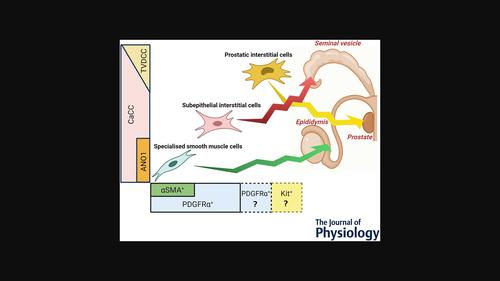Commonality and heterogeneity of pacemaker mechanisms in the male reproductive organs
引用次数: 0
Abstract
During emission, the first phase of ejaculation, smooth muscle in organs of the male reproductive tract (MRT) vigorously contract upon sympathetic nerve excitation to expel semen consisting of sperm and seminal plasma. During inter-ejaculation phases, the epididymis, seminal vesicles and prostate undergo spontaneous phasic contractions (SPCs), this transporting and maintaining the quality of sperm and seminal plasma. Recent studies have revealed platelet-derived growth factor receptor α-expressing (PDGFRα+) subepithelial interstitial cells in seminal vesicles subserve the role of pacemaker cells that electrically drive SPCs in this organ. PDGFRα+ smooth muscle cells in the epididymis also appear to function as pacemaker cells implicating PDGFRα as a potential signature molecule in MRT pacemaking. The dominant mechanism driving pacemaking in these organs is the cytosolic Ca2+ oscillator. This operates through entrainment of the release-refill cycle of Ca2+ stores, the released Ca2+ ions opening Ca2+-activated chloride channels, including in some cases ANO1 (TMEM16A), with the resultant pacemaker potential activating L-type voltage-dependent Ca2+ channels in the smooth muscle causing contraction (viz. SPCs). A second pacemaker mechanism, namely the membrane oscillator also has a role in specific cases. Further investigations into the commonality and heterogeneity of MRT pacemakers will open an avenue for understanding the pathogenesis of male infertility associated with deterioration of seminal plasma.

男性生殖器官起搏器机制的共性和异质性
在射精的第一阶段--排精期,男性生殖道(MRT)各器官的平滑肌在交感神经兴奋下强烈收缩,排出由精子和精浆组成的精液。在射精间歇期,附睾、精囊和前列腺会发生自发性阶段性收缩(SPC),从而运输精子和精浆并保持其质量。最近的研究发现,精囊中表达血小板衍生生长因子受体α(PDGFRα+)的上皮下间质细胞扮演着起搏器细胞的角色,以电驱动该器官中的自发性相位收缩。附睾中的 PDGFRα+ 平滑肌细胞似乎也起着起搏器细胞的作用,这意味着 PDGFRα 是 MRT 起搏的潜在标志性分子。驱动这些器官起搏的主要机制是细胞膜 Ca2+ 振荡器。这种机制通过调节 Ca2+ 储存的释放-再充盈周期来运行,释放的 Ca2+ 离子打开 Ca2+ 激活的氯离子通道,包括在某些情况下打开 ANO1 (TMEM16A),由此产生的起搏器电位激活平滑肌中的 L 型电压依赖性 Ca2+ 通道,导致收缩(即 SPC)。第二种起搏器机制,即膜振荡器也在特定情况下发挥作用。对 MRT 起搏器的共性和异质性的进一步研究将为了解与精浆恶化相关的男性不育症的发病机制开辟一条途径。
本文章由计算机程序翻译,如有差异,请以英文原文为准。
求助全文
约1分钟内获得全文
求助全文

 求助内容:
求助内容: 应助结果提醒方式:
应助结果提醒方式:


